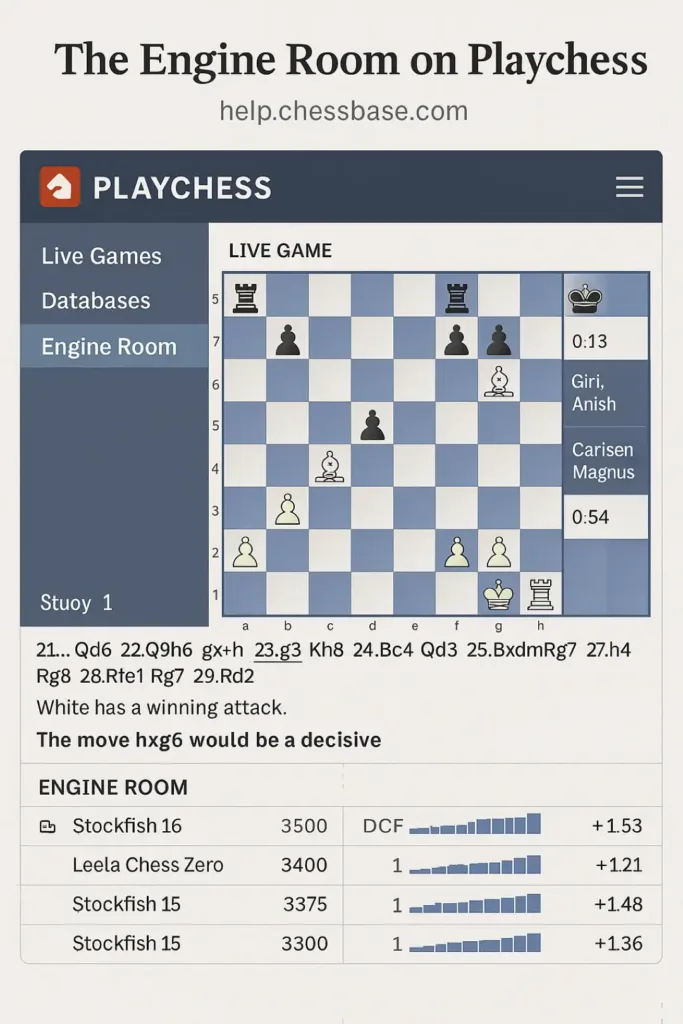Using Cloud Chess Engines in Playchess
Introduction: What Is Playchess and the Engine Room
Playchess is ChessBase official online chess platform, combining live games, databases, commentary, and analysis on a unified, browser‑based and desktop interface (help.chessbase.com). Among its wealth of features, the Engine Room—a place where players can engage with engines for analysis, training, or automated matches—is arguably one of the most powerful tools available to modern chess enthusiasts.
What Is Playchess?
- Live games and tournaments: Playchess serves as a live platform for players worldwide to play games across multiple time controls.
- Seamless integration: Available via standalone clients like Fritz or Komodo, it also offers a browser‑based version (accessible at play.chessbase.com) that integrates your Personal Game Database (“My Games”) and live analysis (help.chessbase.com).
The Engine Room: A Specialist Environment
The Engine Room is a dedicated space on the Playchess server where users can:
- Load both local and cloud engines,
- Analyse critical positions using high‑level engines,
- Host engine vs engine matches, optionally scheduled and automated.
Central to this space is the ability to use Cloud Engines: engines hosted remotely that can be rented or shared—allowing powerful hardware usage without taxing your local machine (help.chessbase.com, help.chessbase.com).
Why Use Cloud Engines?
- Scalable power: From chess‑strength notebooks to desktops and shared engine farms, performance scales based on your needs (en.chessbase.com).
- Convenience: No need to install or configure engines locally—choose from a selection, set your preferences, and instantly begin (help.chessbase.com, help.chessbase.com).
- Cost efficiency: Instead of investing heavily in hardware, you can rent engine time based on usage, paying in “ducats” at pre‑set rates or via auctions (en.chessbase.com).
This powerful combination makes Playchess’s Engine Room a compelling choice for analysis, deep preparation, engine battles, and online play.

The Origins and Evolution of the Engine Room
Understanding how Playchess’s Engine Room developed offers insight into its design, strengths, and innovations.
Early Beginnings
- The Playchess platform launched in early 2000s as an online arena for chess, primarily tied to ChessBase’s desktop ecosystem. Its engine support initially mirrored local engine usage—load a UCI/CECP engine in Fritz or Komodo, then connect it to Playchess.
- With rising demand for remote analysis flexibility, ChessBase introduced the Engine Room, consolidating local and remote engine control into one central hub.
Introduction of Cloud Engines
- Circa 2013–2014, ChessBase launched the Engine Cloud within Playchess and desktop programmes like Fritz 13, ChessBase 15, and Deep Fritz (en.chessbase.com, en.chessbase.com).
- This allowed players to either rent engines publicly, tapping powerful external hardware, or offer their own private engines, enabling remote access to personal engine setups (en.chessbase.com, support.chessbase.com).
Progressive Refinements
- Private engine offers: Users could now access their desktop engines remotely, using portable devices or weaker laptops. Engines marked as “private” show up colour‑coded (e.g. blue) and can be linked only to your account (support.chessbase.com, en.chessbase.com).
- Bidding and queue system: Public cloud engines come with bidding queues. Users can opt for fixed prices, compete for busy engines, or set cost limits automatically (en.chessbase.com).
- Engine matches and tournaments: While full tournaments haven’t been integrated, users can run engine vs engine matches and tactical test suites directly in the Engine Room (en.chessbase.com).
Performance and Community Benefits
- The “Let’s Check” initiative aggregates analysis from engines worldwide, giving live statistics and opening trends during tournaments (en.chessbase.com).
- Engine service providers build credibility via usage stats, ducat revenues and user likes—creating a marketplace prioritised by reliability (en.chessbase.com).
In short, the Engine Room evolved from simple engine hosting to a sophisticated, cloud‑driven ecosystem, enabling powerful remote analysis and engine experimentation.
Detailed Tutorial: Using Cloud Engines in Playchess
Below is a detailed, step‑by‑step guide for players to set up, connect, and use cloud engines in Playchess via the desktop client (e.g. Fritz, ChessBase, Komodo). This tutorial assumes you have:
- A Playchess/ChessBase account,
- Two computers (or alternately, one powerful desktop and one portable client),
- ChessBase-compatible client installed on each,
- Internet access.
1. Preparing Your Remote (Server) Computer
Requirements:
- ChessBase-compatible client (Fritz, Komodo, etc.) installed.
- Register and log in to Playchess using your ChessBase account (support.chessbase.com, en.chessbase.com).
- Ensure the chess engine (e.g., Fritz, Houdini) is not running locally if you intend to make it available as a cloud engine (support.chessbase.com).
Steps:
- Open your engine client (e.g., Fritz).
- Navigate to the Engine tab and select Open Cloud Engines or click the Cloud button (support.chessbase.com, en.chessbase.com).
- Log in to Playchess.
- In the new window, click Offer Private Engine.
- Select your desired engine from the list.
- Confirm; your engine appears in the cloud window, marked blue and accessible only to you (support.chessbase.com, en.chessbase.com).
2. Accessing the Cloud Engine from Your Client (Laptop)
Requirements:
- ChessBase-compatible software on your portable device,
- Same Playchess account and internet access.
Procedure:
- Launch the client and go to the Engine → Open Cloud Engines area (en.chessbase.com, en.chessbase.com).
- Log in to Playchess.
- In the list, your private engine appears with its name in dark blue; public ones show up green/yellow/red based on availability (support.chessbase.com, en.chessbase.com).
- Double-click your engine.
- Configure rental/bidding (private engine: usually free; rental engine: enter ducat limits or bidding) (en.chessbase.com, support.chessbase.com).
- The engine loads into the current board as though local—without CPU usage locally (support.chessbase.com, chessengeria.eu).
3. Working with Cloud Engines
Using the Engine:
- View analysis in real time: the evaluation bar, principal variation, and depth.
- Send/play moves: the engine reacts identically to a local one.
- Stop: click Stop in the cloud dialog; server‑side engine halts (en.chessbase.com, support.chessbase.com).
Controlling Costs (for rentals):
- Set base per minute rate or a fixed price package in ducats (10 ducats ≈ €1) (en.chessbase.com).
- Use automatic bidding during busy periods or set a budget cap for careful cost control (en.chessbase.com).
- Stop the engine at any time to halt spending and save the analysis.
4. Engine vs Engine Matches
- Load two engines (cloud or local) as “White engine” and “Black engine.”
- Let them play a match automatically—handy for testing opening lines, defensive resources, or novel engine versions (en.chessbase.com).
Stage 3: Strengths, Weaknesses and Comparative Analysis
Strengths of Playchess Cloud Engines
- Performance without local CPU drain
You can access high-level engines on remote hardware without taxing your laptop—great for tournament breaks or analysis sessions (chessengeria.eu). - Scalability and adaptability
Rent powerful public engines when needed; otherwise, rely on your private ones. Ideal for customised needs (en.chessbase.com, support.chessbase.com). - Integrated ecosystem
Works with ChessBase collections (e.g., Mega Database), Let’s Check, and live event stats—all inside Playchess (en.chessbase.com, help.chessbase.com). - Flexible pricing models
Control via fixed or bidding systems, cost‑ceiling automation—minimises waste while maximising utility (en.chessbase.com). - Remote engine provisioning
Offer your own engine publicly to earn ducats or privately for personal access—adding both convenience and incentive (en.chessbase.com, support.chessbase.com).
Weaknesses and Limitations
- Cost considerations
Ducat costs (0.01–0.65 ducats/minute or ~€0.003–€0.065) can add up—especially during deep analysis (en.chessbase.com). - Dependency on connectivity
Needs stable internet; latency or connection drops can disrupt engine performance or halt ongoing sessions. - Platform lock‑in
Fully functional only via ChessBase/Fritz clients; no standalone access via open standards or casual web clients. - No full engine tournament integration
While individual matches work, there’s no tournament bracket feature—more manual setup is required (en.chessbase.com). - Learning curve
The bidding system, ducat use, queue colours, and balance settings may confuse beginners without clear documentation.
Comparing with Chess.com and Lichess
| Feature | Playchess (ChessBase) | Chess.com | Lichess.org |
|---|---|---|---|
| Engine power | Top-tier UCI engines; cloud‑rented licences | User‑available engines; Cloud analysis via browser; engine strength limited | Free, open‑source engines (e.g., Stockfish); analysis capped per minute |
| Access method | Desktop/web client, cloud‑rent or private access | Browser, mobile apps; cloud engines with subscription | Browser-based; open Stockfish analysis, no rentals |
| Cost | Pay‑per‑minute ducats; private engines can be free | Premium subscription for unlimited analysis time | Completely free |
| Integration | Deep ChessBase ecosystem (databases, notation, training) | Light databases, puzzles, limited PGN tools | Full PGN editor, LiChess openings explorer |
| Engine pairing | In‑client engine vs engine mode | No built‑in engine match mode | No engine matches; engine play limited to analysis |
| Flexibility | Highly customisable cloud usage | Limited by proprietary platform constraints | Fully open‑source, extensible |
Discussion:
- Chess.com offers convenience and pedagogy—they automate cloud analysis with subscription but don’t offer engine‑vs‑engine matches or remote rentals.
- Lichess excels in open access and community tools, including free Stockfish and exploration; but lacks flexible external engine usage.
- Playchess empowers users who seek maximum engine control, remote deployment, and cost‑effective deep analysis—but has a steeper user learning curve.
Stage 4: Conclusion – Balanced Evaluation and Final Thoughts
Pros of Playchess Cloud Engines:
- High performance: Leverage powerful systems remotely for deep analysis.
- Custom control: Manage engine usage, bidding, and costs flexibly.
- Professional integration: In‑depth compatibility with ChessBase databases, Let’s Check and engine room features.
- Private usage: Access your own engine from anywhere, without hardware constraints.
Cons to Consider:
- Financial commitment: Rental costs may add up for prolonged use.
- Internet reliance: Connectivity problems can halt analysis.
- Proprietary platform: Locked into ChessBase ecosystem; limited outside support.
- Complexity: Bidding system and engine rental may intimidate newer users.
Strategic Comparison:
If you’re a professional or serious chess analyst—
- Looking for painless deep analysis with no hardware investment: Playchess wins.
- Wanting open, free, community‑centric tools: Lichess is ideal.
- Prioritising ease of use and guided learning: Chess.com fits best.
Final Verdict:
Playchess remains the go‑to solution for players seeking full engine customisation, remote performance, and tight integration with ChessBase tools. Its cloud functionality bridges the gap between weak portable devices and powerful desktop hardware. While it has a learning curve and requires budget awareness, for users preparing high‑stakes games, conducting engine tests, or analysing complex positions, Playchess’s Engine Room offers unmatched precision and control.
Sources
- Cloud engines setup and usage details (help.chessbase.com, help.chessbase.com, en.chessbase.com, support.chessbase.com, en.chessbase.com, en.chessbase.com, en.chessbase.com, chessengeria.eu, help.chessbase.com)
- Ducat cost structures, bidding logic, and usage modelling (en.chessbase.com)
- “My Games” browser app integration (help.chessbase.com)

Jorge Ruiz Centelles
Filólogo y amante de la antropología social africana